Honestly, it was difficult to choose three pests for this list because in any given garden in any given year you may be battling different foes. However, the three we’ve chosen for this list are particularly bothersome and show up for most of us annually in our desert vegetable gardens and fruit orchards.
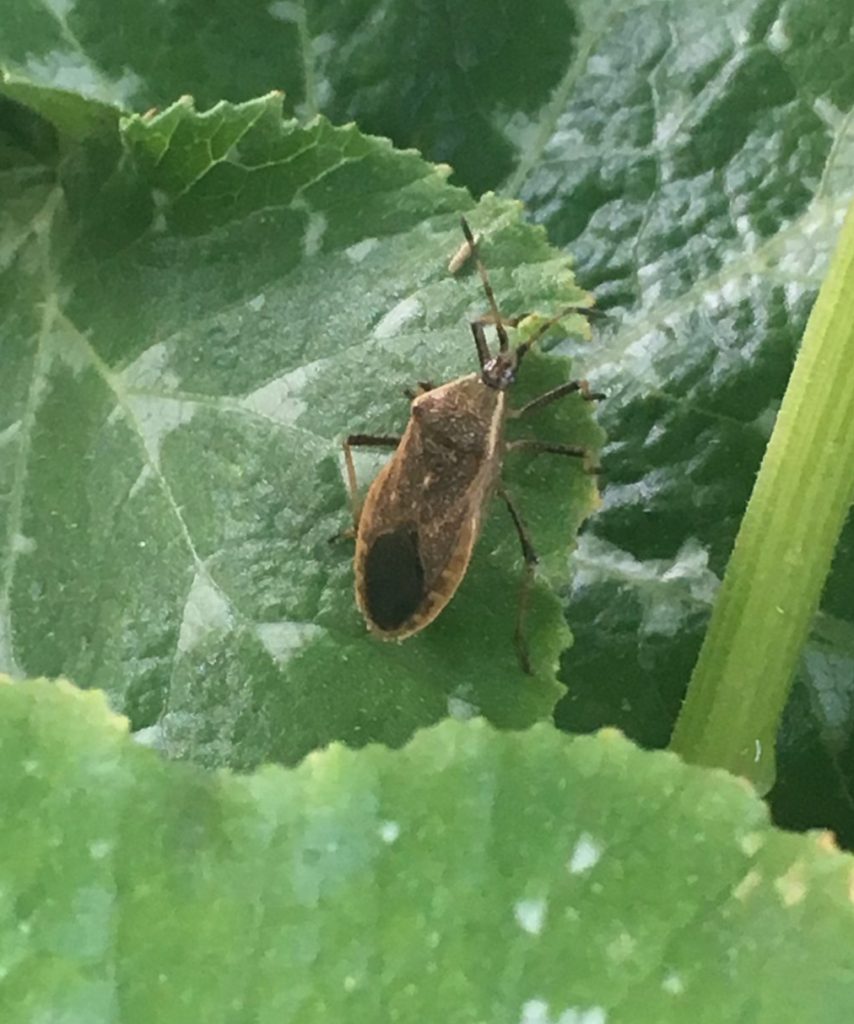
1. Squash bugs
Squash bugs have a hard exoskeleton and appear in the garden in late spring and live through the summer, aligned with squash and melon plants in the garden. Squash bugs are notoriously difficult to control and can wreck serious havoc. Birds will not eat them, and they have been known to crawl around for almost an hour AFTER being cut in half. Often mistaken for stink bugs, they are similar in appearance and also emit an unpleasant odor when squished.
Eggs
Eggs are iridescent orange/brown and clustered on the bottom of leaves.They are very hard and cannot be easily squished. They take ten days to hatch.
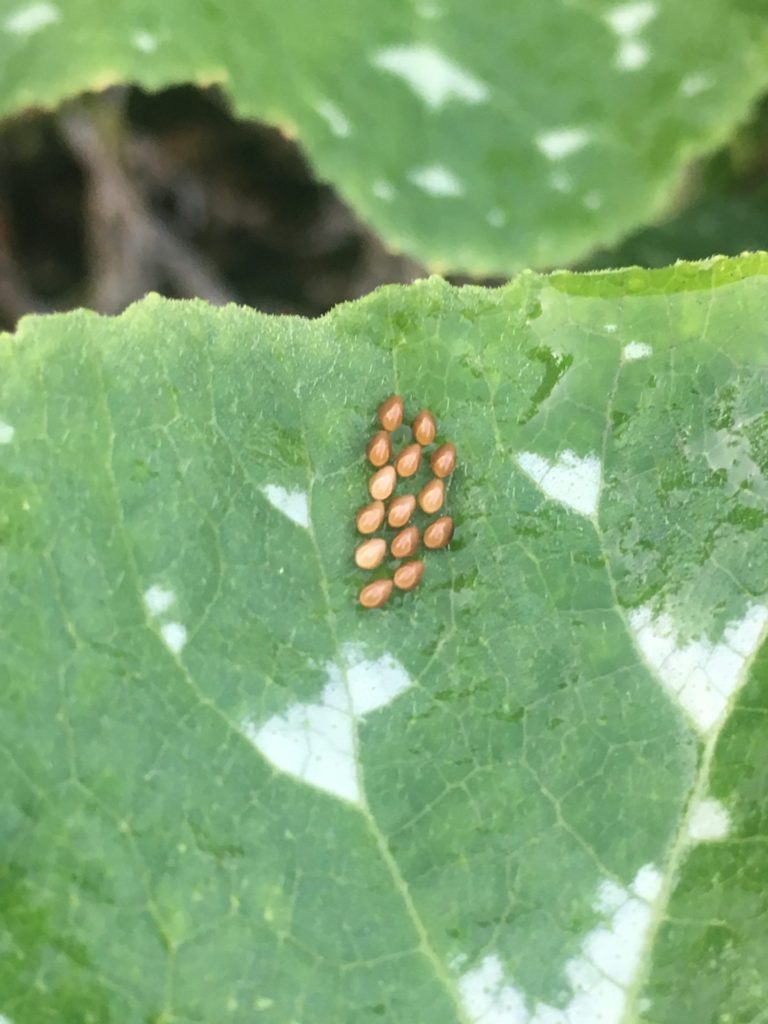
Nymphs
Young squash bugs, also known as nymphs, have curved tear-drop shaped, gray bodies with black legs. They move quickly and often in groups shaded on the undersides of leaves.
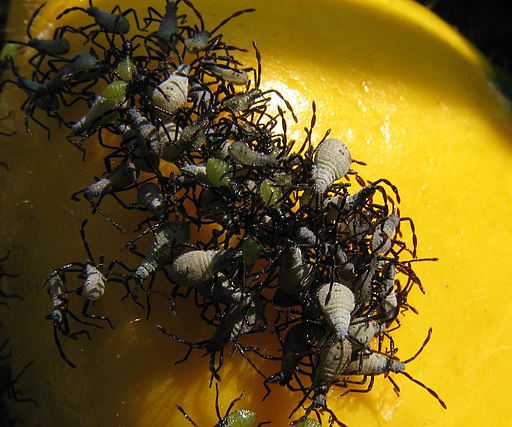
Beatriz Moisset / CC BY-SA
Adults
Adult squash bugs are fairly large (¼-½ inch long) with a hard skeleton and black or brown coloring. They hide in leaf debris and mulch at the base of plants. This is especially bothersome in the desert garden as mulch is crucial to healthy plants.
Squash bugs cause damage by injecting toxin into plants and sucking out sap. Damage appears as:
- Yellowing spots on leaves that turn brown.
- Wilting plants, especially in the afternoon when plants are already stressed by the summer sun.
- Dried, crisp, brittle leaves.
Tips for Controlling Squash Bugs
- Prevention might not always be possible, but dispose of or ensure you fully hot compost old/dead squash plants to prevent squash bugs from overwintering in the garden.
- Manually remove adults, nymphs and eggs by squishing or brushing into a bucket of soapy water. Eggs are difficult to squish and should be scraped off into water. Check daily and remove promptly.
- Spray plants with water daily when severely infected. This causes the bugs to crawl out from hiding and they can then be manually removed.
- Provide Neem Seed Meal as a fertilizer to provide some systemic protection to pests and strengthen plants.
- Place a board in the garden at night near squash plants. Adults and nymphs congregate underneath and can be squished in the morning.
- Make a milk and molasses spray. This easy kitchen ingredients recipe is very effective on soft-bodied insects but can also help with squash bugs. The high sugar content of the spray is difficult or impossible for insects to digest. This is also the reason that healthy plants (high sugar and brix levels) are not attractive to them. Mix 1 tbsp of molasses in ½ cup of milk and spray on pests and plant leaves.
- Practice companion planting. Dill, catnip, peppermint, and tansy repel squash bugs. Bolting radish attracts beneficial predators. Plant squash with pungent plants, so that the scent throws them off. Rosemary, lavender, oregano and yarrow have strong scents.
- Use row covers until blossoming begins to prevent bugs from eating plants and laying eggs on squash plants. Row covers are often under-utilised in the desert garden because we think of them more for cold protection in winter, but they are excellent for preventing pest infestations.
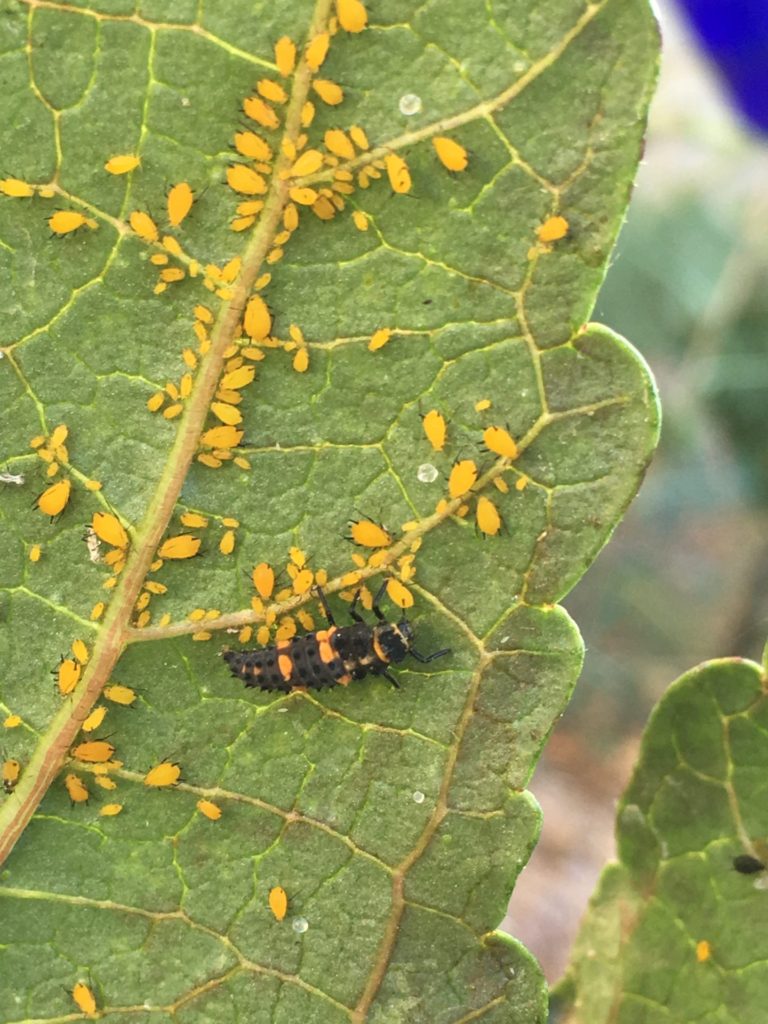
2. Aphids
Aphids are the quintessential garden pest, attacking everything from roses, to tomatoes, to melons. Aphids are soft bodied insects in a variety of colors, including light green, white, grey, and black. They show up in early spring as tender new growth is emerging. In the desert garden, they are also present in fall as it starts to cool down and sometimes are also present in winter when They suck nutrients directly out of plants, weakening the entire plant and reducing fruit production. Aphids are tiny, often under ¼ inch and appear in large numbers. They multiply quickly.
Adult aphids are usually wingless, but unfortunately, most species can develop wings when food becomes scarce, allowing them to fly to new plants and start new infestations.
To identify aphids, look for curled, deformed, stunted, and/or yellowing leaves. Flip these over, as aphids hide in the shade on the underside of leaves. The sucking action of the aphids causes plant liquids, or honeydew, to seep out and attract other insects, often ants. If you notice ants crawling up your plants, keep an eye out for aphids. Some species of ants actually “milk” and protect aphids to continue “farming” the honeydew.
Aphids as an indicator of soil health
Aphids are an amazing indicator of soil health. Aphids actually indicate an imbalance of fertility in the soil, usually an excess of nitrogen. Who would have thought too much of a good thing is actually bad? Reconsider your fertilizer, especially if it is high in nitrogen, and add mulch, which is carbon, to allow soil microbes to utilize more nitrogen in the soil. (If you don’t use fertilizer, be aware that chicken manure and even urine are high sources of nitrogen).
Tips for Controlling Aphids
- Keep an eye on infestations and look for beneficial insects, particularly ladybugs and lacewings, which feast on aphids. Oftentimes beneficial insects can manage an infestation without interference from us! Purchase beneficial insects if you do not see ladybugs and lacewings already. These beneficial insects have a particular appetite for aphids.
- Spray water to dislodge aphids and eggs. Spray during early morning or evening when the sun is off leaves. For heavy infestations repeat every day as necessary.
- Remove highly infested leaves and drown the aphids in soapy water.
- Spread diatomaceous earth at the base of the plant to control ants and dust heavily infested leaves, careful to avoid pollinators and beneficial insects.
- Create a spray of water, dish soap, and cayenne pepper and spray directly on infected leaves daily for at least a week. Spray after the sun has set and rinse off the next morning.
- Neem oil spray is effective in controlling aphids but takes time to disrupt the aphids’ hormones and reproduction.
- Plant trap crops, especially sunflowers, to attract and trap aphids. Native Arizonan sunflowers are able to survive heavy infestations that would otherwise decimate crops.
- Plant pungent smelling companion plants such as peppermint, dill, tansy, and yarrow to confuse and repel aphids.

Thrips damage to citrus
HeberM / CC BY-SA
3. thrips
There are multiple varieties of thrips, which are soft-bodied insects that appear from spring through fall. Thrips notoriously attack rose blossoms and citrus blossoms. They are difficult to see with the naked eye, but appear like tiny moving grains of rice about the width of a sewing needle on light colored blooms. Thrips, like many garden pests, suck out sap and nutrients, stunting plants and damaging fruit. You will likely notice them hop and fly away. Thrips can have up to 15 generations per year.
Thrips damage plants by sucking out nutrients, but these pests can also cause a bacterial/wilt disease that damages plants. Thrips damage appears like scarring/streaks and spots on leaves and fruit.
Tips for Controlling Thrips
- Blue and yellow sticky traps attract and trap thrips.
- Lacewing and ladybug larvae are incredibly effective in eating thrips. Purchase eggs/adults or attract beneficial predatory insects with flowering plants such as dill, fennel, mint, basil, alyssum, and chamomile.
- Spray plants with a kaolin clay mixture to prevent thrips from easily feeding on foliage.
- Spray beneficial nematodes on the soil, which interrupt reproduction and reduce populations. Nematodes should be sprayed over a wide area since they do not travel horizontally in soil.
Need help identifying more desert pests? Want more pest control ideas in an organized format?
Sign up to receive an update when our Insect Identification Printable booklet is ready!

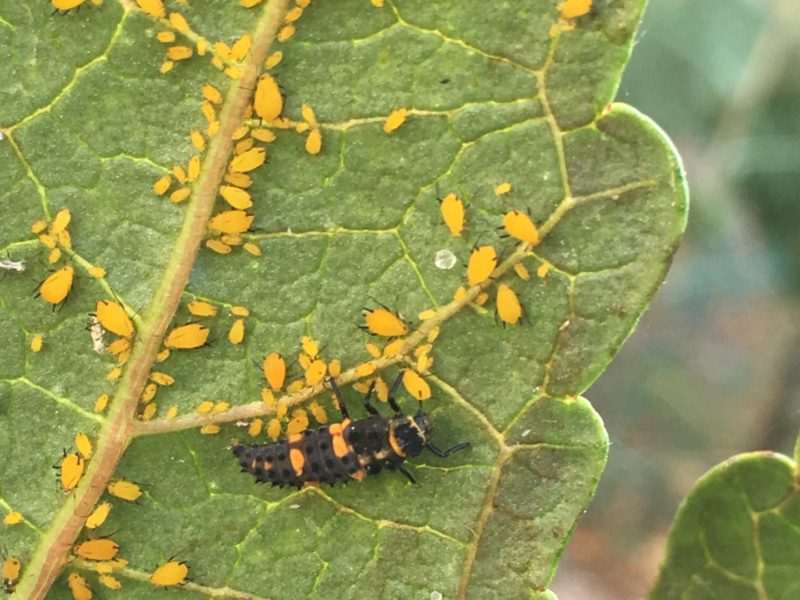
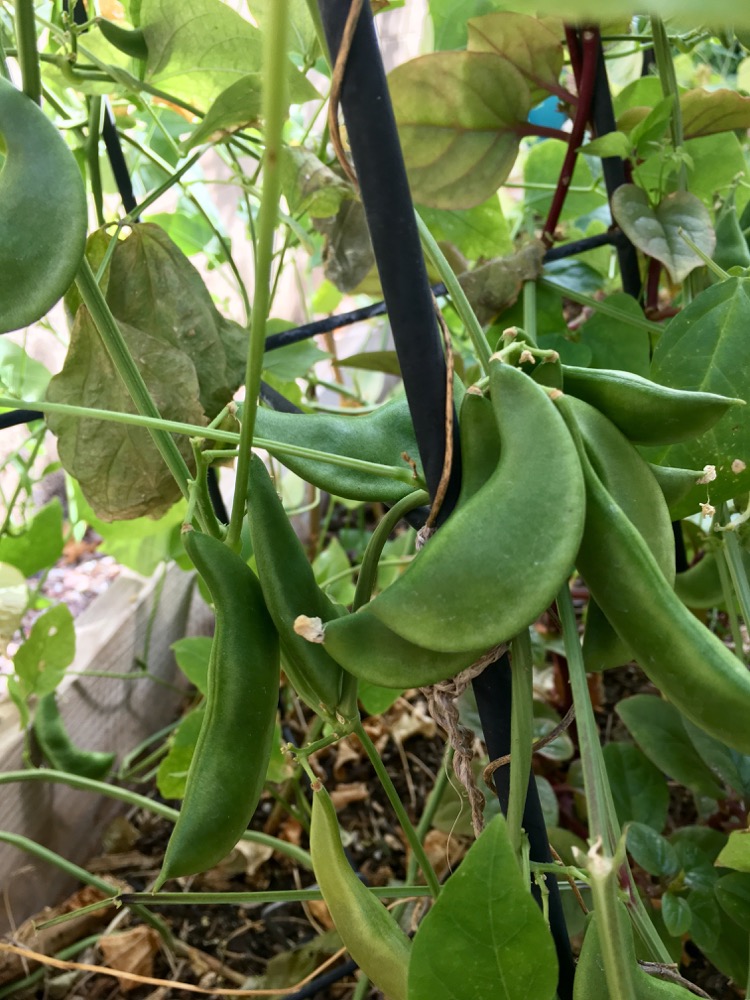
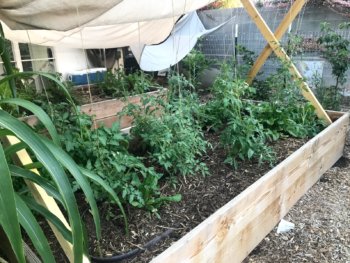
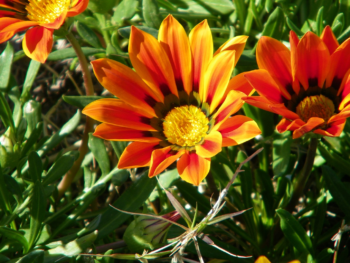

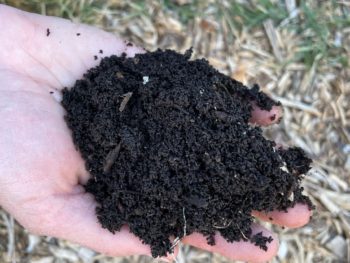
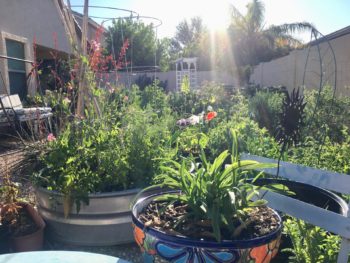

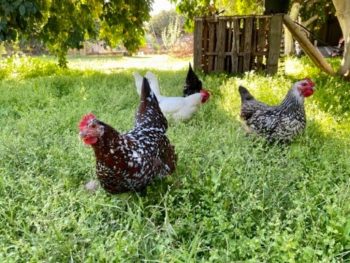
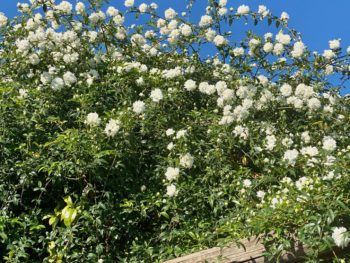
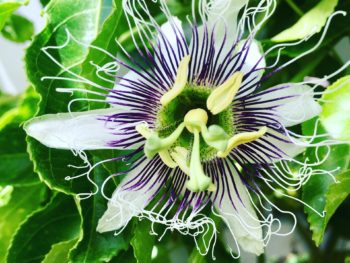
 Tomato Blossom End Rot: The Cause, The Myths, And The Cure
Tomato Blossom End Rot: The Cause, The Myths, And The Cure
Excellent and timely article; I am nursing a few Pumpkin plants right now and dreading the moment when I see those horrible Squash bugs. I also have some very small Cucumbers that I hope to get big enough to produce. And then the Citrus, I need to remember to keep an eye on them as well! Thanks for this and all the excellent content here on Desert Gardening. It is much appreciated.
Thank you so much for the kind words Doug!